Adam Pines

Delineating the development of the brain, cognition, and psychopathology with data science.
“Every science begins as philosophy and ends as art”
| CV | ||
| github | ||
| google scholar | ||
Publications
First-author
Co-existence of negative and positive associations between cognition and intergenerational psychiatric symptoms reveal necessity of socioeconomic and clinical enrichment
Pines, Tozzi, Bertrand … & Williams
Development of Top-Down Cortical Propagations in Youth
Pines, Keller, Larsen … & Satterthwaite, 2023
Dissociable multi-scale patterns of development in personalized brain networks
Pines, Larsen, Cui … & Satterthwaite, 2022
Leveraging multi-shell diffusion for studies of brain development in youth and young adulthood
Pines, Cieslak, Larsen … & Satterthwaite, 2020
Multi-unit relations among neural, self-report, and behavioral correlates of emotion regulation in comorbid depression and obesity
Pines, Sacchet, Kullar …. & Williams, 2018
Co-author
Individual Differences in Delay Discounting are Associated with Dorsal Prefrontal Cortex Connectivity in children, adolescents, and adults
Mehta, Pines, Adebimpe … & Satterthwaite, 2023
Linking Individual Differences in Personalized Functional Network Topography to Psychopathology in Youth
Cui, Pines, Larsen … & Sattherthwaite, 2022
Personalized Functional Brain Network Topography is Associated with Individual Differences in Youth Cognition
Keller, Pines, Sydnor … & Satterthwaite, 2023
The ENGAGE study: Integrating neuroimaging, virtual reality and smartphone sensing to understand self-regulation for managing depression and obesity in a precision medicine model
Williams, Pines, Rosas … & Ma, 2018
A public database of immersive VR videos with corresponding ratings of arousal, valence, and correlations between head movements and self report measures
Li, Bailenson, Pines … & Williams, 2017
Pairwise maximum entropy model explains the role of white matter structure in shaping emergent co-activation states
Ashourvan, Shah, Pines … & Litt, 2021
Associations between neighborhood socioeconomic status, parental education, and executive system activation in youth
Murtha, Larsen, Pines … & Satterthwaite, 2022
Caregiver monitoring, but not caregiver warmth, is associated with general cognition in two large sub-samples of youth
Keller, Mackey, Pines … & Satterhtwaite, 2022
Hierarchical functional system development supports executive function
Keller, Sydnor, Pines … & Satterthwaite, 2022
QSIPrep: An integrative platform for preprocessing and reconstructing diffusion MRI
Cieslak, Cook, He … & Sattherthwaite, 2022
Neurodevelopment of the association cortices: patterns, mechanisms, and implications for psychopathology
Sydnor, Larsen, Bassett, … & Satterthwaite, 2021
A Developmental Reduction of the Excitation:Inhibition Ratio in Association Cortex during Adolescence
Larsen, Cui, Adebimpe … & Satterthwaite, 2022
Characterizing the role of the structural connectome in seizure dynamics
Shah, Ashourvan, Mikhail … & Davis, 2019
Sex differences in functional topography of association networks
Shanmugan, Seidlitz, Cui … & Satterthwaite, 2021
Mobile Footprinting: Linking Individual Distinctiveness in Mobility Patterns to Mood, Sleep, and Brain Functional Connectivity
Xia, Barnett, Tapera … & Satterthwaite, 2022
Developmental coupling of cerebral blood flow and fMRI fluctuations in youth
Baller, Valcarcel, Adebimpe … & Satterthwaite, 2022
An analysis-ready and quality controlled resource for pediatric brain white-matter research
Richie-Halford, Cieslak, Ai … & Rokem, 2022
Preprints
Functional Connectivity Development along the Sensorimotor-Association Axis Enhances the Cortical Hierarchy
Luo, Sydnor, Pines … & Satterthwaite
Compression supports low-dimensional representations of behavior across neural circuits
Zhou, Kim, Pines … & Bassett
A general exposome factor explains individual differences in functional brain network topography and cognition in youth
Keller, Moore, Luo … & Barzilay
Connectional Hierarchy in Human Brain Revealed by Individual Variability of Functional Network Edges
Yang, Wu, Li … & Cui
A Precision Functional Atlas of Network Probabilities and Individual-Specific Network Topography
Hermosillo, Moore, Fezcko … & Fair
Conserved whole-brain spatiomolecular gradients shape adult brain functional organization
Vogel, Alexander-Bloch, Wagstyl … & Seidlitz
About me
I’m a postdoctoral scholar at Stanford in the Williams PanLab researching how cognition and psychopathology interact in the developing brain. I recently completed a neuroscience PhD at the University of Pennsylvania with Ted Satterthwaite, where I studied normative neurocognitive development.
Out of respect for the complexity of the developing brain, I integrate across structural and functional neuroimages at multiple scales of analysis for broad and robust responses to my research questions. For example, in this paper, we wanted to use a precision network mapping approach to delineate individualized cortico-functional cogntiive development in youth. However, the cortex is organized into functional modules at multiple scales. By delineating personalized functional networks across coarse (e.g. 4 functional networks) to fine-grained partitions (e.g., 30 functional networks) in a large developmental cohort, we saw that individual variability in functional topography varies systematically across scales, and the development of functional networks unfolds differently at different scales, with coarse and fine-grained network development harboring distinct ramifications for neurocognitive development.
Out of respect for the scientific community and gratitude for previous generation of open-source scientific code, I’ve created walkthroughs for all of my code underlying every analysis in my first-author papers since learning how to code. All of the code within these walkthroughs (and the walkthroughs themselves) have been independently verified to work as intended by particularly stalwart co-authors. For example, in this pre-print, we were able to build off of fantastic code bases for spherical registration of cortical surfaces (freesurfer) and for tracing the migration of progenitor cells on spherical zebrafish gastrulas to construct, validate, hypothesis-test with, and dissemniate a pipeline for tracking and quantifying the hierarchical movement of cortical activity.
Outside of neuroscience, I am recently a lucky fiancé and a long-time mediocre improvisational musician, enjoy backpacking into the mountains with friends, am an ex-personal trainer, and am active in the great American folk science of meat smoking. Thanks for visiting my page, and feel free to reach out for inquiries.
Thanks for reading. Here are some findings I’d like to highlight:
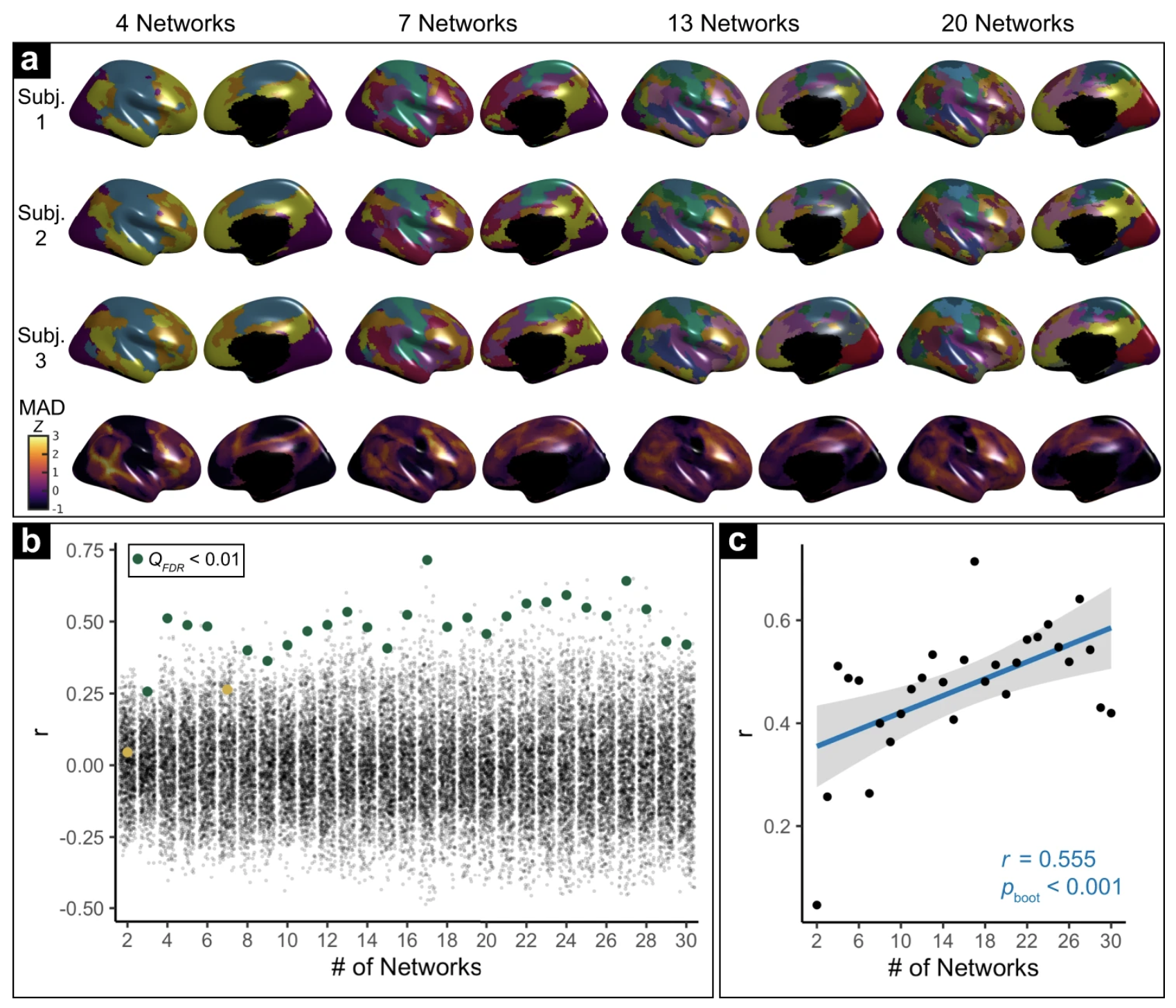
Where in the cortex individual variability in functional arealization localizes is dependent on how granular your definition of functional networks is. More granular = more variability in higher-order cortices. From my nature comms paper.

Functional differentiation proceeds from lower-order to higher-order cortices in development, such that a single unimodal-to-transmodal gradient explains most (r^2=.71) of the developmental variability we observed across functional networks. Functional differentiation is associated with enhanced cognitive capacity, and de-differentiation seems to follow the same spatial trajectory years-to-decades later (still waiting to run this on full lifespan data). From my nature comms paper.

Hierarchical distance provides a parsimonious description of how individual edges in the functional connectome develop. Check out figure S9 to see how it lines up relative to other edge-level descriptions of neurodevelopment. From my nature comms paper.
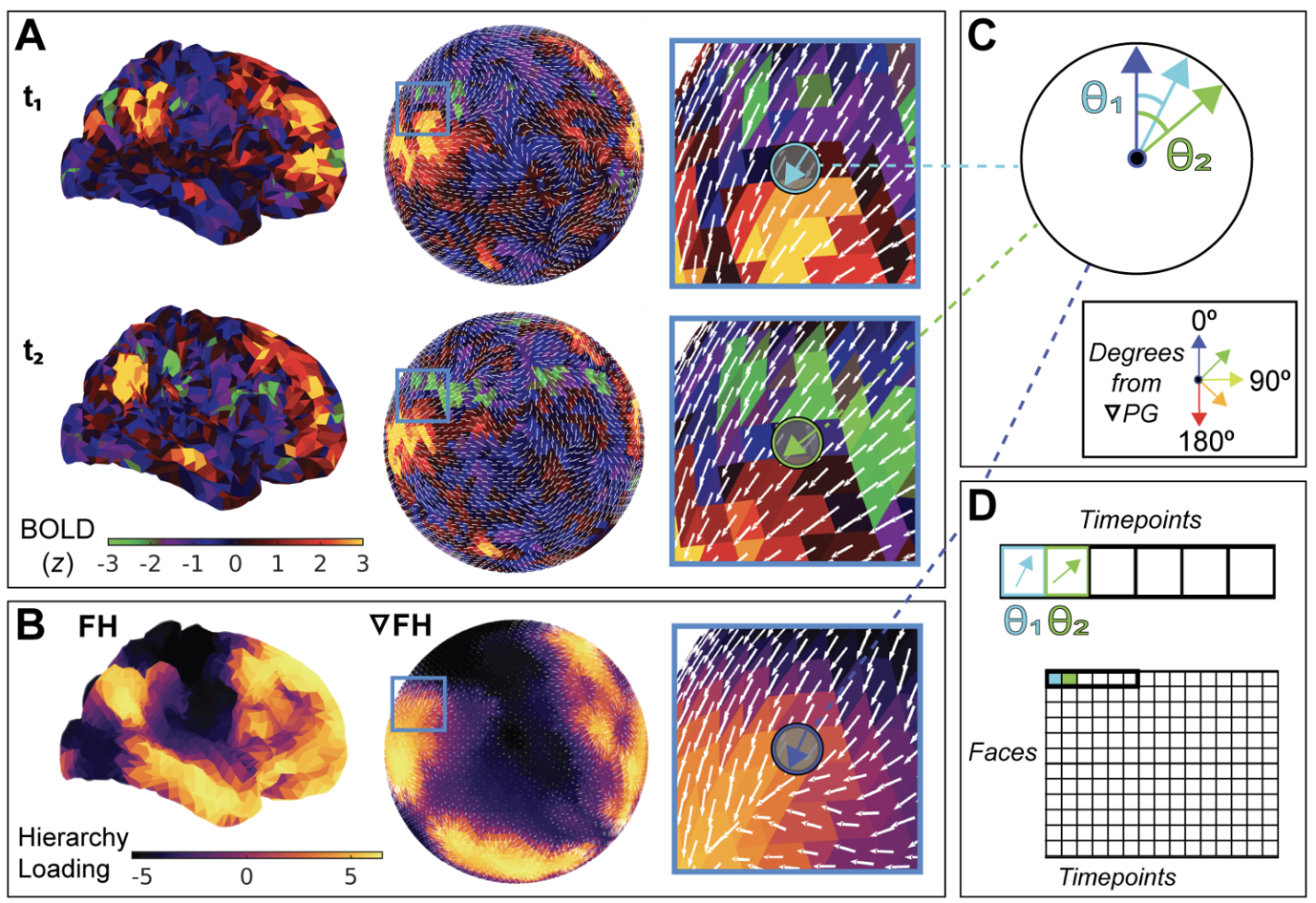
Optical flow can be used to delineate bottom-up and top-down hierarchical propagations in fMRI data. From my neuron paper.
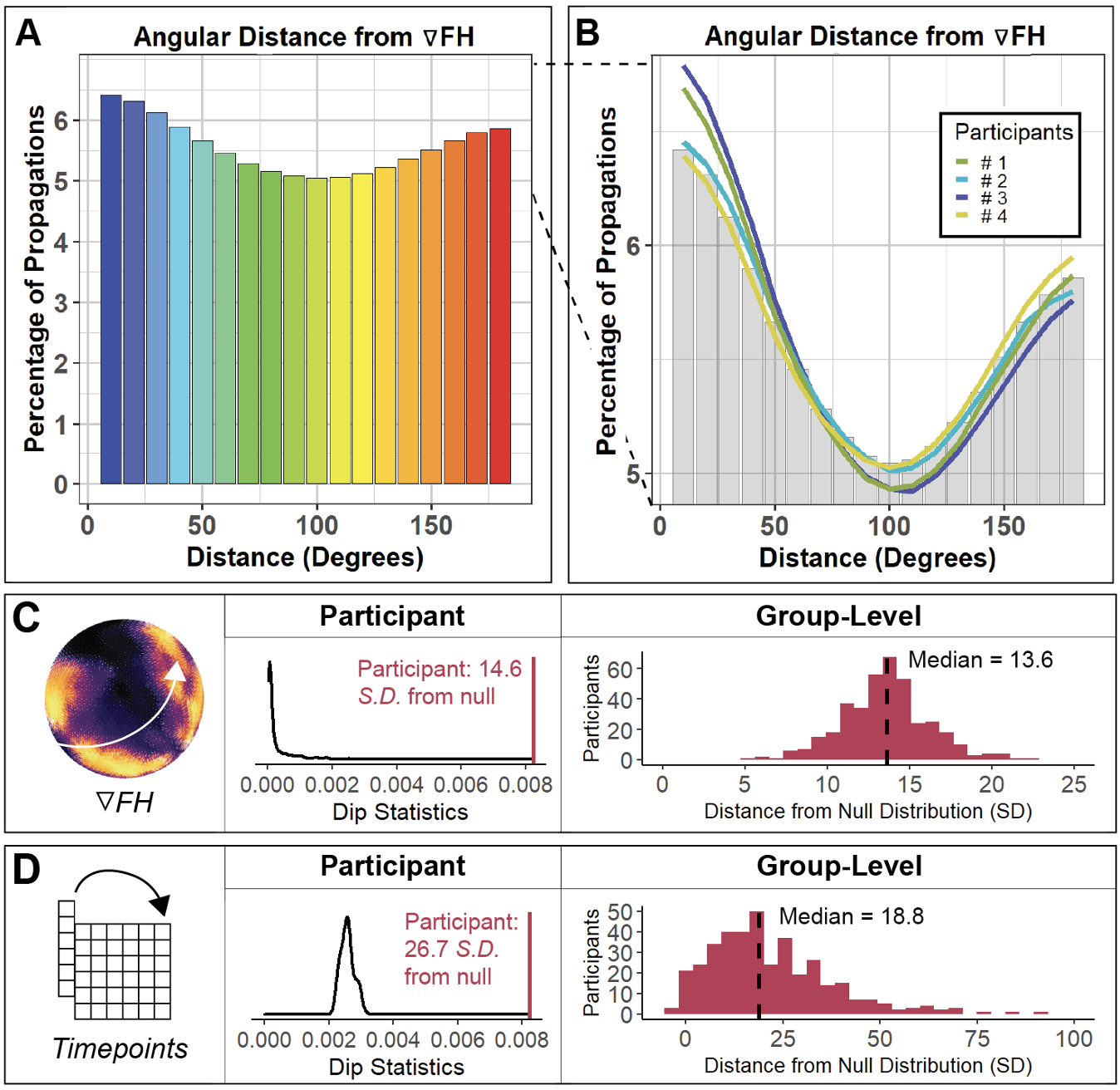
Both bottom-up and top-down propagations are common in all individuals we tested. 2 of 5 verifications of this finding depicted in this figure. From my neuron paper.
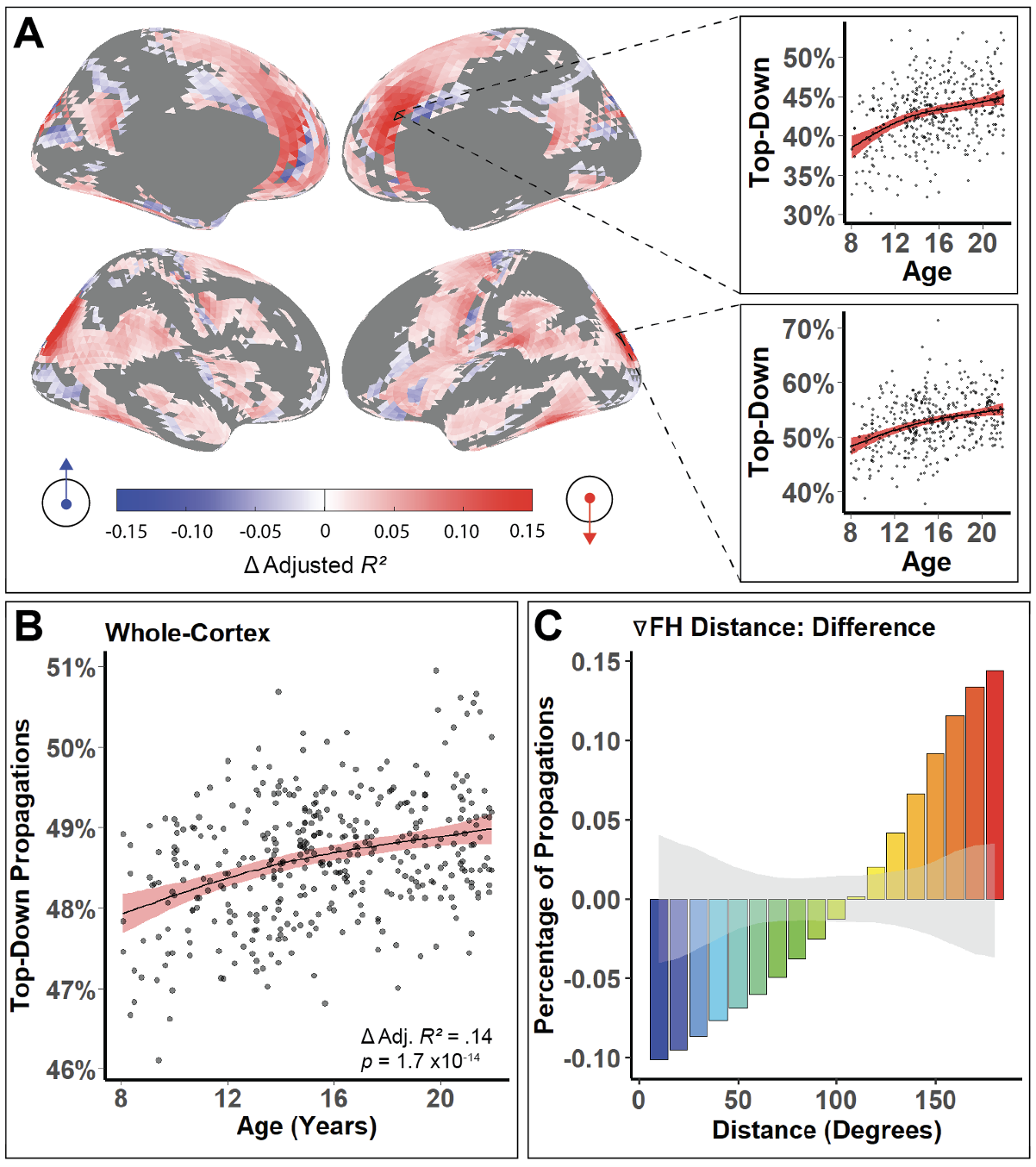
Top-down propagations become increasingly prominent over neurodevelopment. Not pictured is the same results 100% holding after controlling for previously known properties of functional neurodevelopment. From my neuron paper.
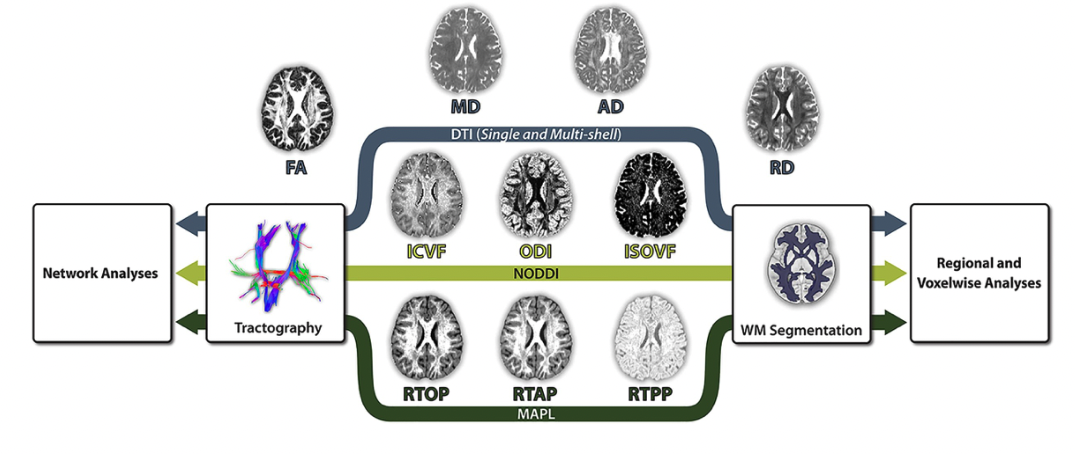
Multi-shell diffusion weighted imaging can be leveraged to confer increased sensitivity to neurodevelopmental effects and decreased sensitivity to the confounding influence of head motion in neurodevelopmental studies. Schematic from my developmental cog. neurosci. paper.
“Every science begins as philosophy and ends as art; it arises in hypothesis and flows into achievement. Philosophy is a hypothetical interpretation of the unknown (as in metaphysics), or of the inexactly known (as in ethics or political philosophy); it is the front trench in the siege of truth. Science is the captured territory; and behind it are those secure regions in which knowledge and art build our imperfect and marvelous world” - Durant